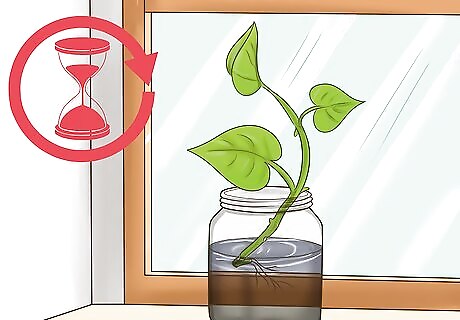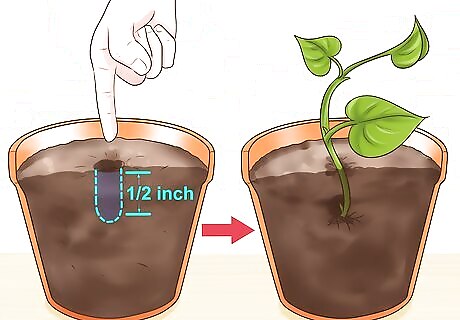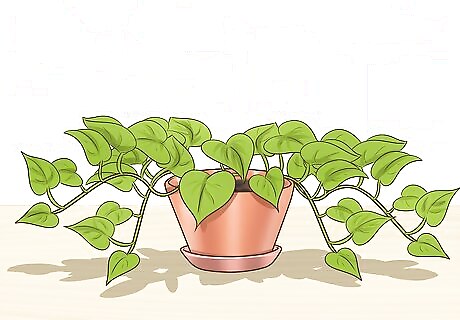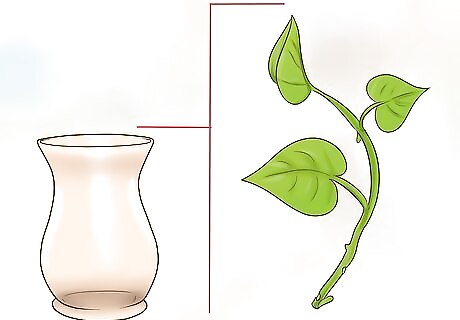
views
X
Research source
Helping it to Grow Roots

Check your chosen vine that you want to cut and see if it is healthy. Do not choose a vine with: Yellowing or decaying of the vine portion More than a few brown, dried leaves Black leaves Decaying/dead growth-tip of the vine

Cut off a piece of vine that's at least 6 inches (15.2 cm) long, has at least 5 healthy leaves, and has nodes. Nodes are brown stubs opposite each leaf stem on the vine. Cut close to a node, because this is where the roots will sprout.

Remove two of the closest leaves to the bottom node. This will prevent the leaves from rotting when placed in water.

Place your cut vine in a jar or container of clean water, only filling the water up to where it covers the bottom one or two nodes. If you want to, you can add a tiny bit of liquid plant fertilizer. Overdoing fertilizer can be bad for your cutting, so if you don't know exactly how much to put, don't risk it.

Put in a place where there is indirect sunlight, and wait. Make sure to check and refill the water level so the node(s) will keep growing roots. Once roots (at least half an inch long) show, you can transplant the cutting quickly if you want your new plant to begin growing in soil. If growing it in water, you can wait to transplant put watch out for stagnating/souring water (pour water out and refill).
Moving it to Soil

Use potting material that is mostly peat and drains well.Whether your plant is growing outside or indoors in a pot, make sure there is at least six inches of soil-depth in which to grow. If using a pot, there needs to be a drainage hole and a water tray underneath. Using fertilizer is unnecessary, as pothos grows fast and it is optional.

With your finger, make a hole that will cover the cutting up to half an inch above its roots. Place the cutting in the hole and place dirt gently over it to fill the hole. Do not pack down the soil.

Water the plant by sprinkling onto the dirt. Watering on top of the leaves won't ensure all the water gets down to the dirt. The potting soil should be moderately moist and an inch of topsoil; not ever overly wet. Puddles and mud are not good for the plant.
Let the plant grow! With good conditions, with a warm winter climate or re-starting each spring, pothos outside can create a "carpet" of leaves. You can use a trellis to encourage the vines to climb; just twine some long vines through/around the structure. Indoors, it can create a curtain of foliage if several vines are placed on a high shelf.

Water moderately when the soil begins getting dry. Don't soak the soil; just water enough to keep it moist.
Moving it to Water

Get a nice ceramic jar, flower vase, or container that is not taller than the cutting. Even a mason jar will work. The container should allow light to reach all of the leaves. .

Using pebbles or marbles, fill the container about 75% of the way up. Using gravel sold for aquariums is another great substrate. If using material collected from outdoors, soak, brush and rinse it thoroughly first to get rid of any dirt. Other alternatives include perlite or Leca as a substrate for propagation.

Make a "hole" through the substrate and place the cutting in it. Gently cover the hole with the rest of the substrate. Choose a fairly long vine to be visually attractive. The roots should be completely covered, and an area up to an inch above the roots can also be covered with substrate (remove leaves that would decay in the water).

Fill the container with water and add liquid fertilizer. Only add enough so that the roots are covered. Some water visible above the substrate level is fine, but avoid putting a lot of the cutting underwater. Liquid fertilizer can be as simple as Miracle-Gro. Always make sure that the fertilizer is for plants in water and that you are dosing correctly.

Let it grow! The vines can make a nice, small centerpiece in a casual room. Check on the water level once a week and refill accordingly.




















Comments
0 comment